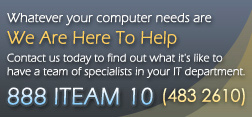Top Mistakes in Website Development
Building a website isn’t as easy as it looks! There are tens of thousands of websites that make common mistakes in content, layout, usability and clarity. Consider some of the most common errors made by developers.
The Boring Website
Your company website should be designed to interest or excite your viewers, not to bore them to tears. A website should pitch your company and its products and services clearly, without unnecessary “fluff” or overly detailed technical information.
The Misleading Website
As always, honesty is the best policy. Your site must accurately portray your company and its products and services. While it is important to sell yourself to potential customers, do not create a false impression through exaggeration.
The Cluttered Website
An uncluttered, clean site is not only visually attractive, but is also effective in making your sales pitch. Limit the amount of content on each page, and avoid overloading your pages with graphics. Your site navigation bar must be consistent – located either across the top, or along the side of your pages.
The Hard-to-Read Website
A common web design flaw is creating pages with text too small for the average reader to view without difficulty. Use an uncluttered sans-serif font (such as Arial or Verdana) with a minimum point size of at least 10 or higher. Black text on a white background is easiest to read. Coloured backgrounds with coloured text usually results in an unprofessional looking, illegible page.
The Slow Website
This is a common error by developers who overload their web pages with high-end multimedia that is only accessible to viewers with high-speed connections. Make your pages accessible to all viewers on any Internet connection.
The Useless Website
The useless website fails to provide the viewer with meaningful information about your company and its products and services. Websites that do not provide basic information, such as product descriptions, will often lead to a frustrating user experience.
The Scrolling Website
The scrolling website refers to improperly designed sites that require long vertical scroll bars, or even worse, horizontal scroll bars, to view the entire page. A website’s horizontal dimensions should never exceed common computer screen widths (that width limit is currently around 740 pixels). A website that is too wide will result in a horizontal scroll bar on a viewer’s browser, one of the worst design mistakes possible.
The Distracting Website
A sure sign of an amateurish website is the use of distracting graphics, or animated gifs. These pesky graphics usually add little value to the content of a web page. Other unnecessary elements include blinking text, silly icons like “top 5% visited site on the web”, and hit counters.
The Reproducing Website
Many companies now provide software to fight reproducing websites. The reproducing site involuntarily opens up pop-up windows when a viewer browses to a certain page. Not only is this distracting, it can be very confusing and frustrating for the viewer.
The Rebel Website
Rebel websites serve less as a source of business information, but more as an outlet for designers to make a statement in an unconventional way. That they defy conventional standards means rebel websites are generally poor in terms of usability, clarity, and content.
The Unlawful Website
Beware of the use of any images or media without the permission of the copyright owner. You have nothing to gain by “borrowing” someone else’s intellectual property. Invest in custom photography or royalty-free images and media, which are relatively inexpensive and readily available.

